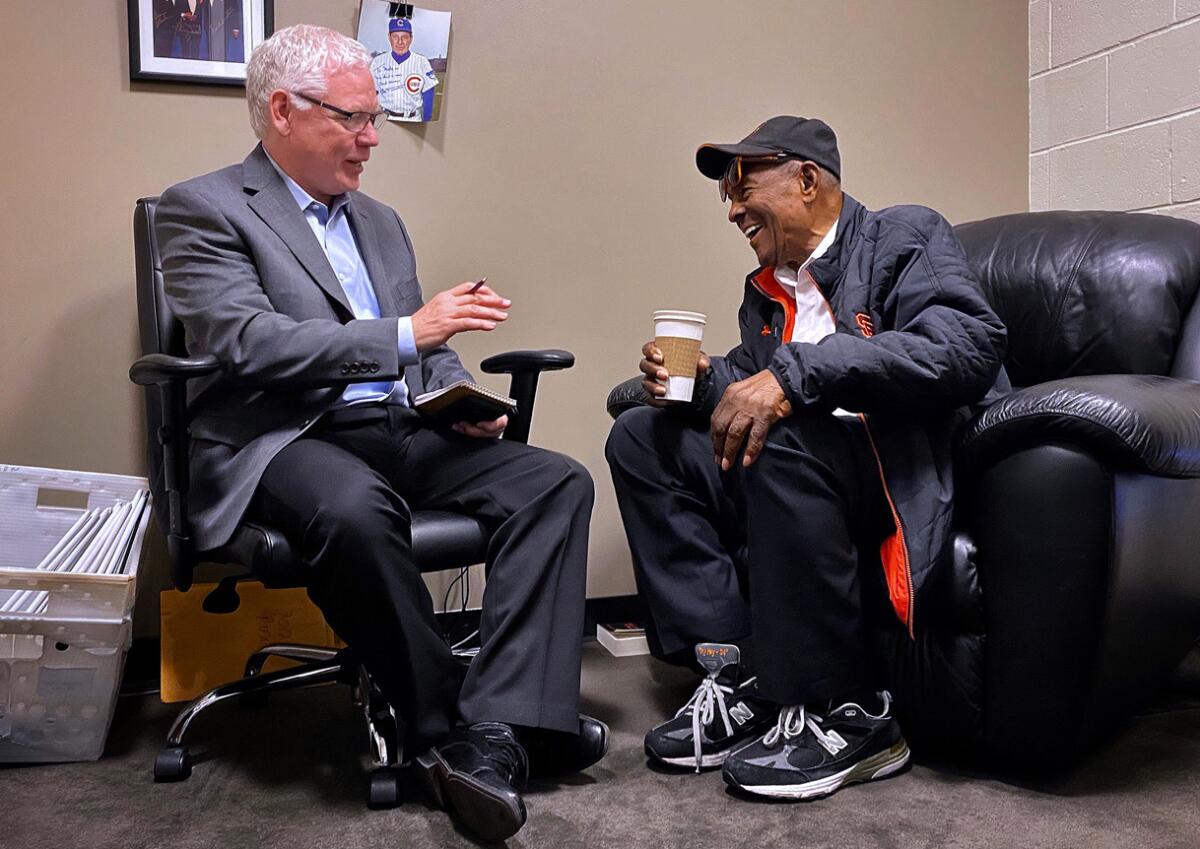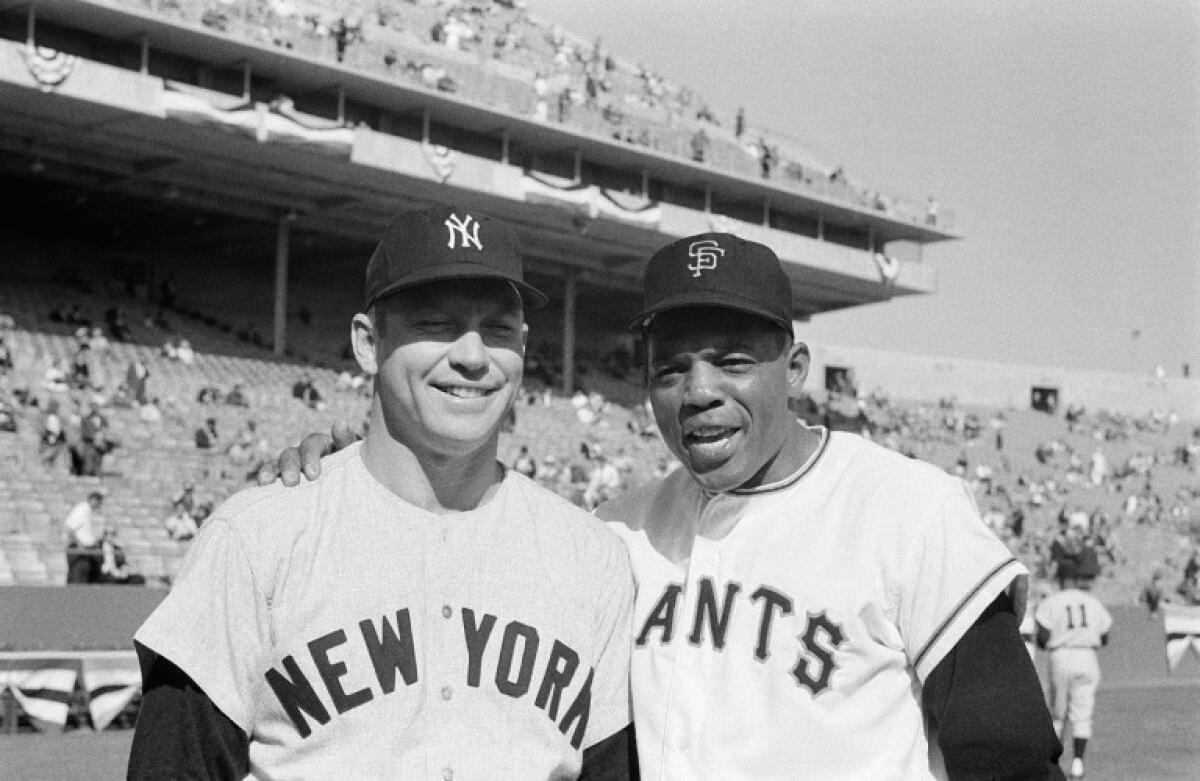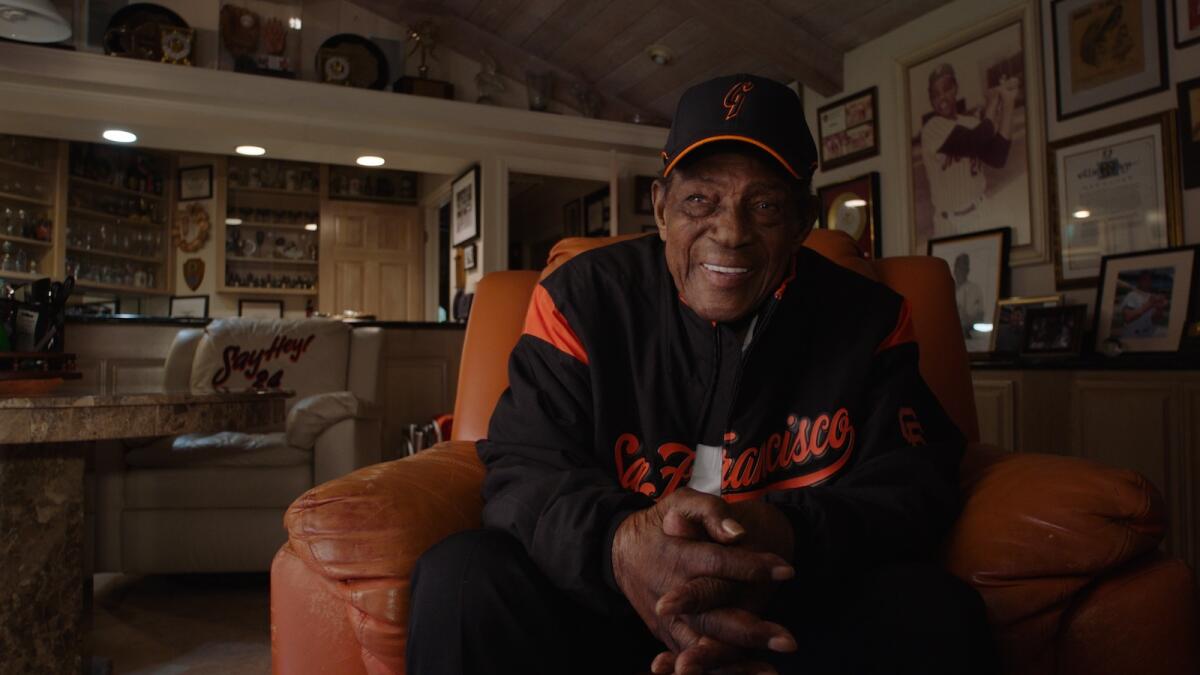-
Winter Storm Is Bringing at Least 6 Inches of Snow to the Northeast - 16 mins ago
-
Texans’ DeMeco Ryans Seemingly Takes Shot at NFL Officiating Following Loss to Chiefs - about 1 hour ago
-
5 major banks offer mortgage relief in fire-ravaged L.A. areas, Newsom says - 4 hours ago
-
How to Watch Texans vs Chiefs: Live Stream NFL Divisional Playoffs, TV Channel, Prediction - 7 hours ago
-
What Border Crisis? Mexican Migrant Shelters Are Quiet Ahead of Trump - 10 hours ago
-
Southern California in ‘uncharted territory’ as fire weather returns all next week - 11 hours ago
-
New Trump Meme Comes With a Legal Waiver - 12 hours ago
-
Mexican Mafia leader offered protection to El Chapo, prosecutors say - 17 hours ago
-
H-E-B Food Recalls: Full List of Products Impacted - 18 hours ago
-
Explosions Heard in Ukraine’s Capital - 21 hours ago
Willie Mays, Hall of Fame Major League Baseball legend, has died
It came to be known simply as “The Catch,” and is, perhaps, the most recognized defensive play in baseball’s long and storied history, the play that made rising star Willie Mays famous.
It was the first game of the 1954 World Series between the Cleveland Indians and New York Giants in New York’s old Polo Grounds.
The Polo Grounds, the Giants’ home field, was an old stadium reminiscent of a gigantic bathtub. The foul-line distances were short, 277 feet in left field, 258 in right, but the center-field fence, the far rim of the tub, was 455 feet from home plate.
Cleveland’s Vic Wertz, a lefty, came to bat with runners on first and second in the eighth inning of a 2-2 tie, facing another lefty, Don Liddle, just in from the bullpen. Liddle, working a 2-and-1 count, threw a fourth-pitch fastball and Wertz tagged what would have been a three-run homer to center field anywhere else.
Not in the Polo Grounds.
It is with great sadness that we announce that San Francisco Giants Legend and Hall of Famer Willie Mays passed away peacefully this afternoon at the age of 93. pic.twitter.com/Qk4NySCFZQ
— SFGiants (@SFGiants) June 19, 2024
Mays, playing a shallow center field, was off at the crack of the bat and, running hard with his back to the plate, caught up to the ball just steps from the wall, snagged it over his left shoulder, pivoted quickly and rifled the ball back into the infield, losing his cap and his balance in the process. The Giants escaped the inning unscathed, then won the game in the 10th on pinch-hitter Dusty Rhodes’ 270-foot pop-fly homer over the right-field fence on the way to a four-game sweep.
Mays, who the San Francisco Giants announced died Tuesday afternoon at age 93, went on to a fabulous career as the flamboyant Say Hey Kid — some consider him the best of the best — but his name and “The Catch” are forever intertwined.
He spent 22 seasons in the major leagues, most with the Giants in New York and San Francisco, leading the team to three National League pennants and a World Series championship. A center fielder who could “do it all,” Mays had a lifetime batting average of .301 with 3,293 hits, 660 home runs — good for sixth on the all-time list — and 339 stolen bases.
He played in a record-tying 24 All-Star games and won 12 Gold Glove awards for his fielding. As demonstrated on “The Catch,” his throwing arm was a cannon, and whatever he did, he did with flair, becoming as famous for his basket catches as he was for running out from under his cap, both afield and on the basepaths.
Said fellow Hall of Fame member and longtime broadcaster Joe Morgan, a Mays contemporary, “Willie Mays is the greatest player I ever saw. … He did something every single day on the field that made you say, ‘Damn!’”
Leo Durocher, who spent a lifetime in baseball as a player and manager, and was Mays’ first manager with the Giants, declared his protégé to be “the greatest ballplayer I’ve ever seen,” and Durocher had seen Ty Cobb, Babe Ruth, Joe DiMaggio, Ted Williams, Stan Musial and Hank Aaron, among other greats.

Sportswriter John Shea speaks with Willie Mays in San Francisco Giants clubhouse at Oracle Park.
(Brad Mangin photo)
Mays’ assessment? Talking to the Contra Costa Times in 2004, he said, “There’s always guys who said I was better than Babe Ruth, better than Aaron. I have no problem with that. … [But] I didn’t play baseball for that. I played baseball to enjoy what I did; the fans enjoyed what I did, and that was enough for me.”
Talking to The Times in 1979, he said, “I’ve always let other people judge. But when you come down to it, there have been better hitters, better runners, a lot of people who could do some things better than me, but I was a complete player. That’s the key word, complete.”
Whether he was the best is an argument for the ages. What’s not arguable is that, as a man seemingly born to play baseball, he generated admiration and controversy in almost equal amounts. Beloved in New York, where he played stickball — a form of baseball using a broom or mop handle and a rubber ball — with neighborhood kids in the streets of Harlem before heading to the ballpark, he was received coolly when the Giants moved to San Francisco in 1958. And there were many who said, “Good riddance!” when he was traded to the New York Mets late in his career.
His casual “Say hey” response to most any greeting was viewed by some as spontaneous and natural, by others as a contrivance for someone who couldn’t recall names. He was praised for his showmanship and damned for his hotdogging when his too-small cap went sailing, often aided by a flick of a finger. And while some thrilled to his running basket catches, others accused him of making routine plays look difficult.
In an age when Black players were trying to finally find a place in what had long been an all-white game, he was subjected to racist taunts yet criticized by others for not speaking out more forcibly about how the game and the fans had mistreated Black players like him. Always high-strung, he was prone to mysterious fainting spells and periods of nervous exhaustion, which led some to question his dedication.
Through it all, Mays played baseball. Into his 40s.
“All I ever did since I was 6 was play ball,” he said once. “I can never understand when some players talk about baseball being hard work. To me, it’s never been nothing but pleasure. … When I was just a little kid in Alabama, my father played semipro baseball and I remember the biggest surprise of my life was the day I found out folks paid him money for it. That seemed to me just about the nicest idea anyone ever thought up — like getting paid for eating ice cream.”
William Howard Mays Jr. — his father was named for former President William Howard Taft — was born May 6, 1931, in Westfield, Ala., near Birmingham. His parents divorced before he was of school age and he went to live with an aunt, but his father, a steel mill worker who had been an outfielder for the Birmingham Black Barons of the Negro National League, looked in on him regularly and made sure young Willie was receiving a proper baseball education.
He was playing sandlot games with boys four or five years older when he was 10, and at 14 joined his father’s steel mill team as a pitcher. In 1948, his father introduced the 17-year-old Mays to Lorenzo “Piper” Davis, the manager of the Black Barons, who worked out the young player, then signed him to a $300 contract — for the season.
Mays played home games and weekend road games for the Black Barons while school was in session, then played full time in center field during summer vacations, quickly drawing the attention of major league scouts. On June 20, 1950, his high school graduation day, he signed with the Giants for a $6,000 bonus.
The Giants sent him to Trenton, N.J., in the Class B Interstate League, where he hit .353 in 81 games, then moved him to Minneapolis in the triple-A American Association at the start of the 1951 season. In 35 games with the Millers, he batted .447 with eight home runs, and his minor league days were over.
The Giants, off to a poor start and looking for a boost, called him up and, despite his protest that he wouldn’t be able to hit big league pitching, thrust him into the starting lineup.

Willie Mays with arm around Mickey Mantle.
(AP)
Eventually, he grew in stature to the point that New York fans conducted a running argument about which of the local teams had the best center fielder, the Giants with Mays, the Yankees with Mickey Mantle or the Brooklyn Dodgers with Duke Snider, but his debut was considerably less than sensational. He had only one hit in his first 26 at-bats, a home run off Warren Spahn of the Milwaukee Braves, and asked Durocher to send him back to Minneapolis.
“You’re gonna play center field for me tomorrow and the day after that, so you better get used to the idea,” Durocher replied. “I don’t care what you hit, I’m not sending you down.”
Bolstered by the confidence, Mays turned his, and the Giants’, season around. He hit .274 with 20 home runs, and the Giants, 13 ½ games behind Brooklyn in mid-August, came storming back to tie the Dodgers for the pennant on the last day of the season, forcing a three-game playoff. Mays was on deck in the ninth inning of the third game when Bobby Thomson hit “The shot heard round the world,” the three-run homer that won the National League championship for the Giants.
The surge ended in the World Series, the lordly Yankees winning in six games, but Mays was on his way and Durocher gave him full credit. “The spark was Mays,” he said. “When it looked like we couldn’t win, he carried us on his back. He carried the whole damn team on his back.”
Mays was on his way, all right, right into the Army. Drafted in May 1952, he spent the next two seasons playing ball in khaki, then was discharged in March 1954, just in time to have the finest season of his career. He hit a league-leading .345, 51 homers and drove in 110 runs as the Giants finished five games ahead of second-place Brooklyn, then swept the Indians in the World Series.
Mays, batting .304 with 49 home runs and 141 RBIs, led the Giants to another World Series in 1962 but by then the team had moved to San Francisco, where he never quite clicked with the fans the way he had in New York.
Playing center field in wind-whipped Candlestick Park was always a chore, and although Mays did it extremely well, was always a home run threat, consistently hit over .300 and was widely recognized elsewhere as a star of the first magnitude, many San Franciscans considered him, at best show-offy, at worst rude and distant, preferring to lavish affection on the Alou brothers, Jesus, Matty and Felipe; Juan Marichal; Willie McCovey; and others.

Baseball Hall-of-Famer Willie Mays in the documentary “Say Hey, Willie Mays!”
(HBO Sports Documentaries)
Today, however, in tribute to Mays, a larger-than-life bronze statue of him stands in Willie Mays Plaza at Oracle Park in downtown San Francisco, and he was voted into the Hall of Fame as soon as he was eligible.
In May 1972, a 41-year-old Mays was traded back to New York, where, well past his prime, he spent two forgettable seasons with the Mets. He played in another Bay Area World Series after the ’73 season, his last, but baseball followers everywhere, purists and casual fans alike, cringed as the former style master stumbled around the Mets’ outfield against the Oakland Athletics, who repeated as champions in seven games.
“Growing old is just a helpless hurt,” Mays said afterward, and later admitted, with regret, that he had extended his career by about two seasons too many.
In retirement, he worked intermittently for the Mets and Giants and finally signed a lifetime public relations contract with the Giants in 1993. For six years, however, he was out of baseball after then-Commissioner Bowie Kuhn, unhappy about any link between baseball and gambling, banned both Mays and Mantle because they had taken public relations jobs with Atlantic City casinos.
Both were reinstated in 1985, after Peter Ueberroth replaced Kuhn as commissioner.
Mays’ wife of 41 years, Mae Louise, died in 2013. He is survived by his son Michael.
Kupper is a former Times staff writer
Source link












